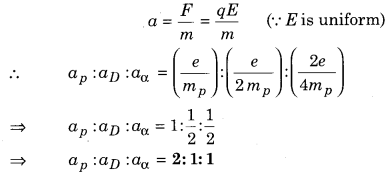Rajasthan Board RBSE Class 12 Physics Chapter 1 Electric Field
RBSE Class 12 Physics Chapter 1 Text Book Exercise with Answers
RBSE Class 12 Physics Chapter 1 Multiple Choice Type Questions
RBSE Solutions For Class 12 Physics Chapter 1 Question 1.
Two equal charges are placed at a distance of 3 m. A repulsive force of 1.6 N acts on it. The value of each charge will be :
(a) 2 μC
(b) 4 μC
(c) 40 μC
(d) 80 μC
Answer:
(c) 40 μC
Given r = 3 metre
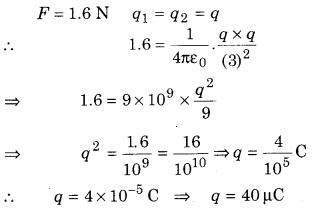
RBSE Class 12 Physics Chapter 1 Solution Question 2.
F is the force between two charges. If the distance between them is tripled, then force between the charges will be :
(a) F
(b) \(\frac{F}{3}\)
(c) \(\frac{F}{9}\)
(d) \(\frac{F}{27}\)
Answer:
(c) \(\frac{F}{9}\)
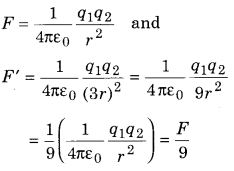
RBSE Class 12 Physics Chapter 1 Numericals Question 3.
To charge an object with a positive charge of 5X10-19C, the number of electrons withdrawn from it will be :
(a) 3
(b) 5
(c) 7
(d) 9
Answer:
(a) 3
Given q = 5 × 10-19C
q = ne
∴ n = \(\frac{q}{e}=\frac{5 \times 10^{-19} \mathrm{C}}{1.6 \times 10^{-19}}\)
∴ n = 3
RBSE Class 12 Physics Chapter 1 Question 4.
Two point charges +9e and +e are at distance 16 cm. Where should another charge q be placed to be in equilibrium?
(a) 24 cm away from +9e charge
(b) 12 cm away from +9e charge
(c) 24 cm away from +e charge
(d) 12 cm away from +e charge
Answer:
(b) 12 cm away from +9e charge
Let we place charge q at distance x from charge 9e

RBSE Solutions For Class 12 Physics Question 5.
Two spheres have equal and opposite charges and are at a distance of 90 cm from each other. They are touched together and then are placed at their initial position; then they show a repulsive force of 0.025 N. The final charge on them will be :
(a) 1.5 μC
(b) 1.5 C
(c) 3 C
(d) 5 C
Answer:
(a) 1.5 μC
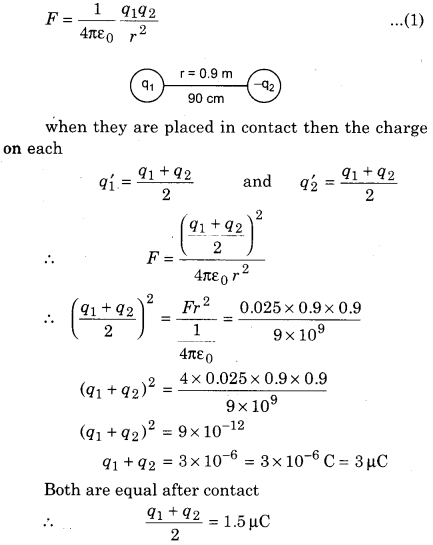
RBSE 12th Physics Chapter 1 Question 6.
If a glass plate is placed between two charges. Then, compare the electric force with the initial condition. It will be :
(a) more
(b) less
(c) zero
(d) infinite
Answer:
(b) less
On placing the glass plate between the charge, the electric field will decrease as comparison to previous.
Physics Class 12 Chapter 1 RBSE Question 7.
The dipole moment of HC1 molecule is 3.4 × 10-30 cm. The distance between its ions will be :
(a) 2.12 × 10-11 m
(b) zero
(c) 2 mm
(d) 2 cm
Answer:
(b) zero
Ions are bound to each other, thus the distance between them will be zero.
Class 12 Physics RBSE Chapter 1 Question 8.
An electron and a proton are placed in a uniform electric field. The ratio of their acceleration will be :
(a) zero
(b) mp / me
(c) 1 (one)
(d) me / mp
Answer:
(b) mp / me

RBSE Solution Physics Class 12 Question 9.
Like charges are placed at the four corners of a square. If the electric field intensity at the centre of the square is E due to any charge, then the resultant electric field at the centre of the square will be :
(a) zero
(b) E
(c) E/4
(d) 4E
Answer:
(a) zero
As the components of electric field intensity at diagonal are equal in magnitude and opposite in direction, thus the intensity, of electric field will be zero.
RBSE Solution Class 12 Physics Question 10.
When an electric dipole is placed in a uniform electric field, then :
(a) only torque acts
(b) only force acts
(c) both force and torque acts
(d) neither force nor torque acts
Answer:
(a) only torque acts
On placing the electric dipole to an uniform electric field, only torque will act.
Class 12 Physics RBSE Solutions Question 11.
For the torque to be maximum for an electric dipole placed in a uniform electric field, the angle between \(\vec{p}\) and \(\vec{E}\) should be :
(a) 0°
(b) 180°
(c) 45°
(d) 90°
Answer:
(d) 90°
τmax = pE sin90° = p
Here, θ = 90°
12th RBSE Physics Solution Question 12.
An electron and a proton are at a distance of 1 A. The dipole moment of the system is :
(a) 3.2 × 10-29 Cm
(b) 1.6 × 10-19 Cm
(c) 1.6 × 10-29Cm
(d) 3.2 × 10-19 Cm
Answer:
(c) 1.3 × 10-29Cm
p = q × 2l = 1.6 × 10-19 × (1× 10-10)
= 1.6 × 10-29Cm
RBSE Class 12 Physics Chapter 1 Pdf Question 13.
Due to an electric dipole, the ratio of electric field intensities of a point which is at equal distance from longitudinal and transverse positions, will be :
(a) 1 : 2
(b) 2 : 1
(c) 1 : 4
(d) 4 : 1
Answer:
(b) 2 : 1

RBSE Solutions Class 12 Physics Question 14.
An attractive force of 9 N acts between +5 μC and -5 μC at some distance. These charges are allowed to touch each other and are then again placed at their initial position. The force acting between them will be :
(a) infinite
(b) 9 × 109 N
(c) 1 N
(d) zero
Answer:
According to the question

RBSE Solutions For Class 12 Physics Chapter 3 Question 15.
Two unlike charges equal in magnitude are placed at some distance and force of F Newton acts between them. If 75% of charge from one is transferred to another. Then, how much would the value of force become :

Answer:
(b)
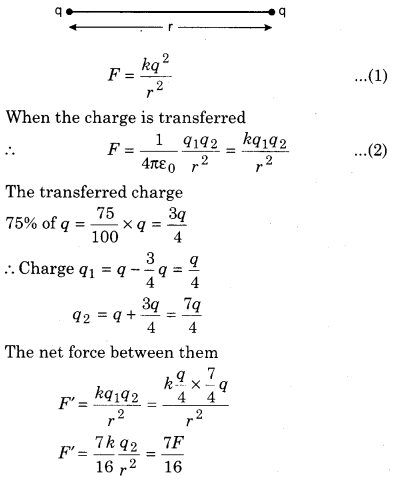
RBSE Class 12 Physics Chapter 1 Very Short Answer Type Questions
RBSE Class 12 Physics Chapter 1 Notes In English Question 1.
Write the value of one quantum charge.
Answer:
One quantum charge = 1.6 × 10-19C
RBSE Solution Class 12th Physics Question 2.
The electrostatic force between two protons placed at distance r is F. If we keep electrons in place of protons, then what would be the effect on electrostatic force?
Answer:
Charge on proton = Charge on electron
∴ There will be no change in electrostatic force.
∴ Electrostatic force = F
RBSE Solutions 12 Physics Question 3.
The electrostatic force on a charge due to another charge is F. In presence of one more charge, what would be the electrostatic force on first charge due to second charge?
Answer:
In the presence of other charge there will be no effect on electrostatic force. Thus electrostatic force will remain same (F).
Physics Class 12 RBSE Solutions Question 4.
If the dielectric constant of a medium is unity, then what would be its relative permittivity?
Answer:
Absolute permitiivity ε = εr × ε0
= 1 × 8.85 × 10-12
= 8.85 × 10-12 C2/N-m2
RBSE Solutions For Class 12 Physics Chapter 4 Question 5.
For two point charges and q1 and q2, q1q2 < 0. What is the nature of electrostatic force between two charges?
Answer:
If q1q2 < 0, then either of q1 or q2 is positively charged and the other is negatively charged and there is force of attraction between them.
RBSE Solutions Physics Class 12 Question 6.
For two point charges q1 and q2, q1q2 > 0. What is the nature of electrostatic force between two charges?
Answer:
If q1q2 > 0, then both q1 and q2 are likely charged (either both positively charged or negatively charged) and there will be electrostatic force of repulsion between them.
12th Physics RBSE Solutions Question 7.
What would be force acting on charge q placed in an electric field E?
Answer:
Acting force = Charge × electric field intensity
⇒ \(\vec{F}\) = q \(\vec{E}\)
RBSE 12 Physics Solutions Question 8.
What is the effect of speed on the mass and charge of a charged particle?
Answer:
If speed v ≈ c (speed of light), then due to increase in speed the mass will increase and charge remains constant.
Physics Solution Class 12 RBSE Question 9.
What is the magnitude of electric field intensity that balances the weight of an electron. It is given that e = 1.6 × 10-19C and me = 9.1 × 10-31 kg.
Answer:
For the equilibrium of electron

Physics Class 12 Chapters RBSE Question 10.
The electrostatic force (F) acts between two point charges in vacuum. If a brass plate is placed between the two charges. What would be the value of electrostatic force?
Answer:
Force acting between two point charge in vacccum F = \(\frac{1}{4 \pi \varepsilon_{0}} \frac{q_{1} q_{2}}{r^{2}}\) force between point charge in medium
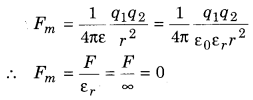
Physics Class 12 Chapter 1 Questions And Answers Question11.
Name the experiment that established the quantum nature of electric charge.
Answer:
Millikan’s oil drop experiment,
RBSE Solutions For Class 12 Physics Chapter 2 Question 12.
Give the definition of electric dipole moment.
Answer.
The dipole moment of an electric dipole is a vector whose magnitude is either charge times the separation distance between the two opposite charges and the direction is along the dipole axis from the negative to the positive charge.
\(\vec{p}\) = q \(2\overrightarrow { \alpha } \)
RBSE 12th Physics Solution Question 13.
What is the condition of an ideal electric dipole?
Answer:
We can think of an ideal dipole in which size 2α → 0 and charge q → ∞ in such a way that the dipole moment, p = q × 2α a has a finite value, such a dipole of negligibly small size is called an ideal or point dipole.
RBSE Solutions For Class 12th Physics Question 14.
Give an example of a particle for which the rest mass is zero and uncharged.
Answer:
The particle is photon.
Physics RBSE Class 12 Question15.
On what factors does the constant k = \(\frac{1}{4 \pi \varepsilon_{0}}\) depends?
Answer:
Constant k = \(\frac{1}{4 \pi \varepsilon_{0}}\) depends on the medium and system of measurement.
RBSE Class 12th Physics Solution Question 16.
Write the value of charge (in coloumbs) on the nucleus of 7N14.
Answer:
As q = Ze
q = 7e= 7 × 1.6 × 10-19C= 11.2 × 10-19C
RBSE Class 12 Physics Question 17.
Why does the ebonite rod becomes negatively charged when it is rubbed against fur?
Answer:
Because electrons in fur are loosely bound as compared to ebonite.
Solution Of Physics Class 12 RBSE Question 18.
Write the CGS and SI units of charge. Give the relation between them.
Answer:
The CGS unit of charge is esu or stat-coulomb and SI unit of charge is Coulomb (C).
1 Coulomb = 3 × 109 esu
12 RBSE Physics Solution Question 19.
When does an electric dipole comes in stable condition when placed in uniform electric field?
Answer:
When \(\vec{p}\) and \(\vec{E}\) are parallel, i.e. when angle between them is zero.
RBSE Solutions For Class 12 Physics Chapter 1 In Hindi Question 20.
What is the resultant force on an electric dipole placed in uniform electric field?
Answer:
Zero.
RBSE Class 12 Physics Chapter 1 Short Answer Type Questions
RBSE Solutions For Class 12 Physics In Hindi Question 1.
What is meant by frictional electricity? Give the brief description of its origin.
Answer:
Frictional electricity is the electricity produced by rubbing two suitable bodies and transfer of electrons from one body to other. The body which looses the electrons, becomes positively charged while the body which receives the electrons, becomes negatively charged.
Physics Class 12 RBSE Question 2.
State the Coulomb’s law for the force acting between two definite point charges.
Answer:
According to Coulomb’s law, “the force of interaction between two point charges is directly proportional to the product of magnitude of charges and inversely proportional to the square of separation distance between them.”
For vacuum or air, F = \(\frac{1}{4 \pi \varepsilon_{0}} \frac{q_{1} q_{2}}{r^{2}}\)
RBSE Class 12 Physics Chapter 1 Notes Question 3.
Explain the quantization of charge.
Answer:
Charge quantization means that charge cannot take any arbitrary values but only values that are integral multiples of the fundamental charge (charge of electron/proton). The basic cause of quantization is that only integral no. of electrons can be transferred from one body to another. Thus an object’s charge can be exactly 0 or exactly q = ±ne i.e., 1e,- 1e, 2e,- 2e…. etc.
RBSE Solution Of Class 12th Physics Question 4.
Write the superposition principle for electrostatic forces.
Answer:
The principle of superposition states that when a number of charges are interacting, the net electrostatic force an a given charge is the vector sum of the forces exerted on it due to all other charges. The force between two charges is not affected by the presence of other charges.
RBSE Class 12 Physics Solution Question 5.
The electric field intensity at a point on the line joining two point charges is zero. What can you conclude about the charges?
Answer:
It means both the charges are of same nature, so the electric field intensity is zero.
RBSE Class 12th Physics Question 6.
In an electric field E, a unit negatively charged ion and an electron are moving. Which one of them move fast and why?
Answer:
Electron will move with fast speed because its mass is less than unit negative charged ion. Due to capture of electron, the mass of unit negative charged ion will be more.
Physics Class 12 Chapter 1 Question 7.
What is the electric field lines? Write any two of its properties.
Answer:
An electric field line iS an imaginary line or curve drawn from a point of electric field such that tangent to it (at any point) give the direction of electric field at that point. Properties :
- Electric field lines starting from positive charge and terminating at negative charge.
- The number of field lines that starts or end at a charge is directly proportional to magnitude of the charge.
12th Physics Solution RBSE Question 8.
Explain the law of charge conservation.
Answer:
It states that “In an isolated system, the total charge is always conserved and in any process of interaction, it does not vary.”
RBSE 12th Class Physics Solution Question 9.
Define the relative permittivity of a medium.
Answer:
The amount by which the force between the charge (in presence of medium) is relatively less than that in vacuum, is called dielectric constant of that medium or relative permittivity (εr)

12 Physics RBSE Solutions Question 10.
How can you charge (positively) a metallic sphere without touching it?
Answer:
(a) Uncharged metal sphere.

(b) Bringing negatively charged rod near to the sphere.
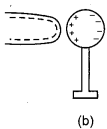
(c) On earthing the metal sphere by conduction wire, the negative charge passes to earth, on the other hand, due to attraction force of negative charges, the positive charge bound to it.
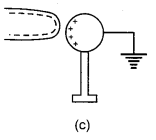
(d) On breaking the earthing, the positive charge remains bound to sphere.
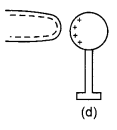
(e) On remaining electrified rod, the positive charge spreads uniformly on sphere.

Class 12 Physics RBSE Question 11.
How can you show that there are two kinds of charges?
Answer:
If two glass rods after rubbing with silk, hang near to each other, then they repel each other, figure (a)]. In the same way two ebonite rods after rubbing with cat’s skin hang near to each other, then they also repel to each other, [figure (b)]
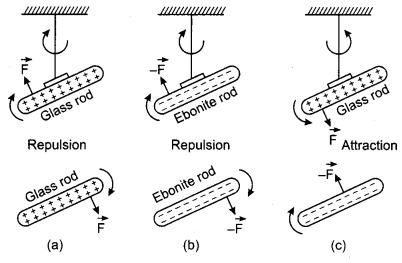
But when glass rod after rubbing with silk and ebonite rod after rubbing with cat’s skin hang near to each other, then they attract to each other, (figure (c)]. It is clear that charges on glass rod and ebonite rod are opposite. It means that charges are of two types. Charges present in glass rod is called positive charge or vitreous and charge present in ebonite rod is called negative charge or resinous.
RBSE Class 12 Physics Chapter 1 Solution In Hindi Question 12.
Related to charges, what does q1 + q2 = 0 represent?
Answer;
q1 + q2 = 0 indicates that one charge is positive and second is negative. The magnitude of both charges is equal.
RBSE Solutions For Class 12 Physics Chapter 1 Question 13.
An electric dipole is placed in a uniform electric field. Show that it will not accelerate.
Answer:
In uniform electric field on electric dipole two equal forces will act in opposite direction, which produce a torque. Therefore electric dipole will not perform translatory accelerating motion.
RBSE Class 12 Physics Chapter 1 In Hindi Question 14.
A charged rod R is attracted by another charged rod P, whereas charged rod Q shows repulsion with rod P. What would be the nature of force between Q and R?
Answer:
Attraction force.
Question 15.
To determine the electric field due to a point charge, the test charge should be small. Explain why?
Answer:
The magnitude of the test charge must be small enough so that it does not disturb the distribution of the charges whose electric field we wish to measure otherwise the measured field will be different from the actual field.
Question 16.
A copper sphere of 2 gm has 2 × 1022 atoms. The charge on the nucleus of each atom is 29e. How many fraction of electrons be eliminated to provide a charge of 2μC to the sphere?
Answer:
Charge on each nucleus = 22 eC
∴ Net charge on nucleus of sphere of mass 2 gm
= (22 e) × (2 × 1022C)
= (4.4 × 1023)eC
∴ Total number of electron on sphere
= (4.4 × 1023)
[∵ Sphere is initially uncharged]
∴ Number of electrons in charge of 2 × 10-6)C
= \(\frac{2 \times 10^{-6}}{1.6 \times 10^{-19}}\) = 1.25 × 1013
∴ Fraction of electrons, which is to be removed
= \(\frac{1.25 \times 10^{13}}{4.4 \times 10^{23}}\)
= 2.84 × 102-11
Question 17.
Two identical metallic sphere of equal mass are taken. One of them is given negative charge and the other is charged positively. Would there be any difference in mass? If yes, then why?
Answer:
The metallic sphere which gets negatively charged gains electrons and hence its mass increases. The metallic sphere which gets positively charged looses electrons and hence its mass decreases.
Question 18.
Electric field decreases when going far from the point charge. This is true for an electric dipole. Does the electric field decreases at the same rate in both the cases?
Answer:
For electric dipole at axial and equatorial positions, for far points (r >> 2l) electric field E ∝ \(\frac{1}{r^{3}}\) and for single charge, electric field E ∝ \(\frac{1}{r^{2}}\) case of electric dipole electric field decreases comparatively for single charge.
Question 19.
What would be the element X in the following nuclear reactions using the law of charge conservation
(a) 1H1 + 4Be9 → X + 0n1
(b) 6C12 + 1H1 → X,
(c) 8N15 + 1H1 → X + 2He4
Answer:
(a) 5B9
(b) 7N13
(c) 6C12
Question 20.
A charged particle is free to move in an electric field. Is this always move in the direction of electric field lines?
Answer:
The tangent at any point to the line of force gives the direction of electric field and force on a charge at that point. If the charged particle starts from rest, it will move along the line of force. If it is in motion and moves initially at an angle with the line of force, then resultant path is not along the line of force.
RBSE Class 12 Physics Chapter 1 Long Answer Type Questions
Question 1.
Define Coulomb’s law for electrostatic force between two charges. Also write its limitations. Give definition of unit charge using this law.
Answer:
Coulomb’s Law
Each electric charge affects its surroundings. In this way, the surroundings mutually interacts and forms a force between its charges, called the electric force. In 1785, on the basis of experiments, Coulomb gave a law related with the force produced by two point charges. This law is called Coulomb’s law. According to this law, “the force of interaction between two point charges is directly proportional to the product of charges and inversely proportional to the square of the distance between them.”
If the two point charges q1 and q2 are placed at r distance, then
F ∝ q1q2 ………….. (1)
and F ∝ \(\frac{1}{r^{2}}\) …………….. (2)
⇒ F ∝ \(\frac{q_{1} q_{2}}{r^{2}}\) ⇒ F = \(\frac{k q_{1} q_{2}}{r^{2}}\) …………….. (3)
Here, k is a proportionality constant and its value depends upon the nature of medium between the charges and the unit system.
For vacuum or air (in S.I. unit)
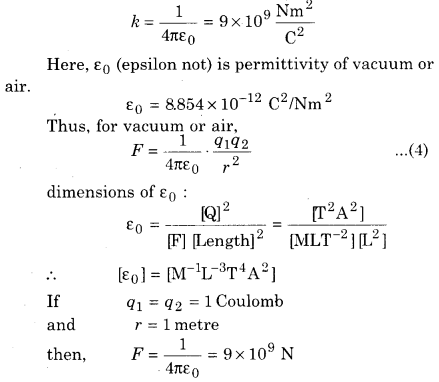
This means that if maintaining a distance of lm between two bodies of same charge in vacuum or air. a force of 9 x 109 N acts between them. Then, the charge on each quantity is equal to one Coulomb. For a medium other than vacuum,
Vector Representation of Coulomb’s Law
Since force is a vector quantity. Thus, it is useful to write Coulomb’s law in vector form. For this, let us consider that two point charges q1 and q2 are placed at position vector \(\overrightarrow{r_{1}}\) and \(\overrightarrow{r_{2}}\) in vacuum. According to fig. 1.7, the position vector of q2 with respect to q1 will be,
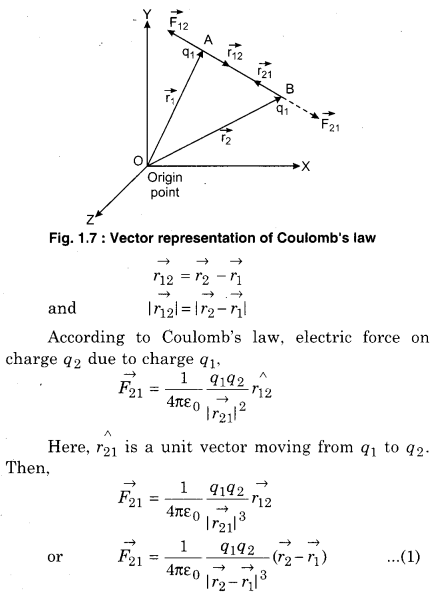
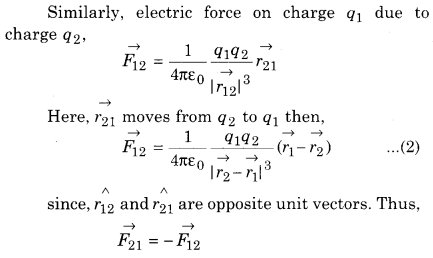
So, we get to know that the force acting due to two charges are equal in magnitude but opposite in direction (whatever kind of charges they may). Thus, Coulomb’s law is in accordance with Newton’s third law of motion. Force is in the direction of the line joining the charges. Thus, constant electric force is central force.
Question 2.
Define electric field. Obtain the formula for electric field intensity at a point due to point charge. What would be the value of electrostatic force on bringing another charge q0 in this field?
Answer:
Electric Field
If an electric charge is placed close to another charge, it experiences a force of attraction or repulsion. If we want to find force between these charges, then Coulomb’s law is sufficient. Similarly, to determine force on a system of charges, Coulomb’s law and superposition principle are used. Now, the question arises, how does force act between the two point charges that do not touch each other ? In other words, how does a charge know about other charges? For answering such question, the concept of electric field is very useful. To understand this process, it can be imagined that each charge develops a field in which when another charge is placed, then an action is done by first charge on second charge due to which the second charge experiences the presence of first charge.
Electric field due to a charge is the space around the charge in which electrostatic force of attraction or repulsion due to the charge can be experienced by any other charge. In this way, a particle is said to be in a
electric field when the particle experiences electrostatic force. The concept of electric field was first given by scientist Faraday. Electric field is a vector quantity which is represented in mathematical form as electric field intensity.
Consider an arbitrary point O, at which a point charge (+Q) be placed. Let the distance between this charge with another charge at P be r. Let a test charge (+q0)be placed at point P. (see fig. 1.12).

The force on positive test charge q0 at P due to charge +Q, by Coulomb’s law,
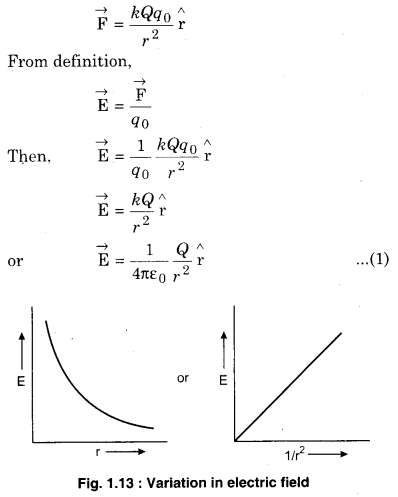
The direction of electric field at point \(\overrightarrow{\mathrm{P}}\) will be towards \(\overrightarrow{\mathrm{OP}}\)
Intensity of electric field at P due to -Q charge
\(\overrightarrow{\mathrm{E}}=\frac{1}{4 \pi \varepsilon_{0}} \frac{Q}{r^{2}}(-\hat{\mathrm{r}})\)
Its direction will be opposite to \(\overrightarrow{\mathrm{OP}}\)
Thus, it is clear that for point charge,
\(E \propto \frac{1}{r^{2}}\)
Thus, the electric field intensity is inversely proportional to the square of distance. The graph between electric field intensity and distance is shown in fig. 1.13.
If the point charge is placed in a medium of dielectric constant εr Then the electric field

Thus, for a dielectric medium, the value of electric field intensity is εrtimes less than that in vacuum.
Question 3.
What is an electric dipole? Give the definition of dipole moment. Obtain the formula for electric field intensity at a point on the axial line due to an electric dipole.
Answer:
Electric Dipole and Dipole Moment
“When two equal and opposite charges are situated at a small distance, then they form electric dipole. The product of a magnitude of either charge and distance between the charges is known as electric dipole moment. It is denoted by \(\vec{p}\) and it is a vector quantity. Its direction is from negative charge to positive charge”

Suppose +q and -q form the electric dipole and the distance between them is 2α. Therefore electric dipole moment.
p = q × 2α ………… (1)
In vector form
\(\vec{p}\) = q × \(2\overrightarrow { \alpha } \)
∴Unit of p = C.m.
and dimensional formula of p = A1T1L1 = [M0L1T1A1]
Other unit of electric dipole is debye
1 debye = 1 × 10-18 Statecoulomb-centimetre
1 debye = 3.33 × 10-30C-m
Definition of ideal dipole moment : The arrangement, in which the size of charge is very large and the separation between tends to be zero is called ideal dipole moment.
but q = ∞ and 2α = 0
∴ p = q × 2l = ∞ × 0 = finite value
Physical Significance of Dipole :
Polar and non polar molecules : When in any molecule the positive and negative charges are uniformly distributed i. e., the centres of positive and negative charges are coincide each other, then the molecule is called non-polar molecule. Such molecules are electrically neutral.
On the other hand if the centres of positive and negative charges are different, then the molecule is said to be polar molecule.
For example : HCl molecule is polar molecule because in it H+ and Cl– ions are bounded be electrical attraction between them. The effective distance between positive and negative ions in these molecules is nearly 10-11 m. Thus the molecules of electrolytes are polar molecules, e.g, HCl, H2O, NaCl, AgNO3 etc. are the examples of electric dipole.
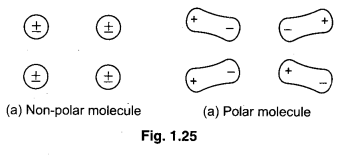
Electric Field at a Point on the Axial Line of an Electric Dipole
Fig. 1.26 shows an electric dipole. We have to calculate electric field at P which is at ‘ r’ distance from the mid point O. The charges on the dipole are -q and +q respectively.
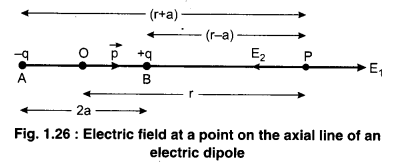
Electric field at point p due to charge -q on point B,
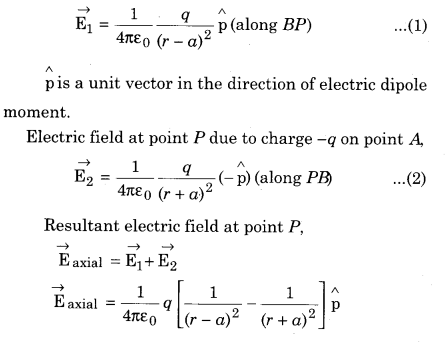
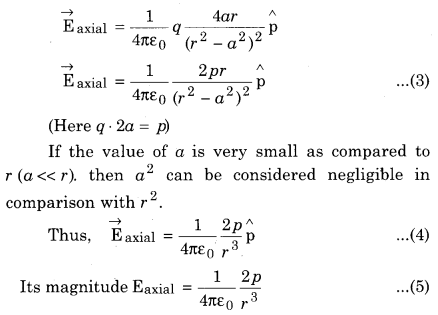
From the above calculations, it is clear that on the axis of the dipole, the electric field intensity does not depend upon r-2 as a single charge does, whereas it depends upon r-3. Thus, the electric field intensity decreases rapidly with distance.
Question 4.
Obtain the formula for electric field intensity at a point on the equatorial line due to an electric dipole. >
Answer:
Electric Field at a Point on the Equatorial Line of an Electric Dipole
In fig. 1.27, an electric dipole AB is shown. The charges at point A and B are -q and +q respectively and the distance between them is \(2\overrightarrow { \alpha } \). We have to calculate electric field intensity at point O.
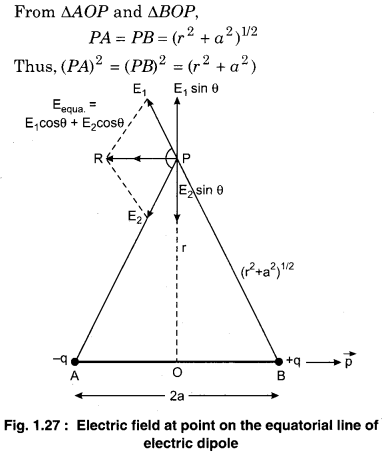
Electric field at point P due to charge +q,
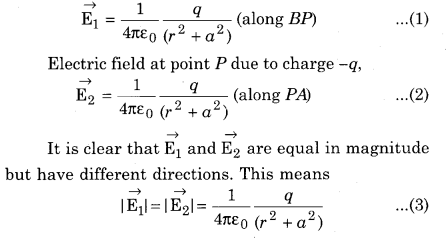
According to the figure 1.27 the vertical components of E1 and E2 (E1 sinθ and E2 sinθ) gets cancel out due to in opposite direction and the horizontal components (E1 cosθ and E1 cosθ) are in same direction so they are added.
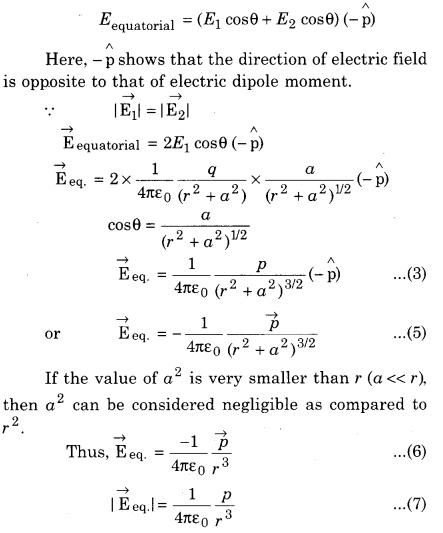
It is clear that equal distance r,
Eaxial = 2Eequatorial
Thus (i) the electric field intensity placed at axis is twice the electric field at point on the equatorial line of the electric dipole.
(ii) The direction of electric field at a point on the axial line of the dipole is in same direction whereas it is in opposite direction in case when the point is at equatorial line of the electric dipole.
It is clear that for both the cases (axial and equatorial), for distant points (r >> 2a), the electric field, E ∝ \(\frac{1}{r^{3}}\).
Question 5.
An electric dipole is placed in uniform electric field \(\vec{E}\). Obtain the formula for the torque acting In which condition, it is maximum?
Answer:
Torque on a Dipole in a Uniform Electric Field
An electric dipole is placed in uniform electric field at an angle ‘θ’ with field as shown in figure 1.28. The forces (qE) acting on the dipole make a couple of force. The force create turning effect of motion which is known as torque.
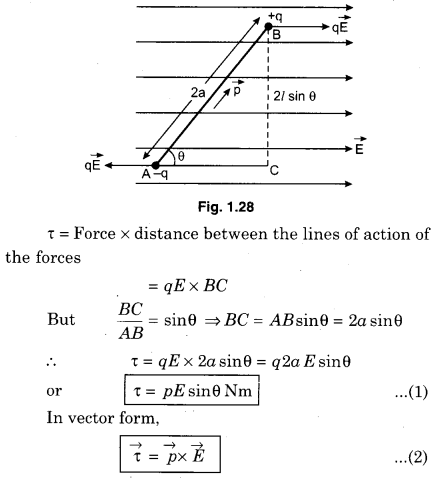
The direction of \(\vec{\tau}\) can be decided with the help of right hand screw law. It is shown in fig. 1.29. The direction of \(\vec{\tau}\) is perpendicular to. \(\vec{E}\) as well as to \(\vec{p}\) both.
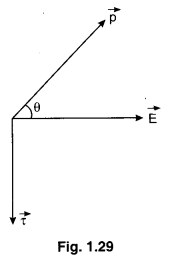
Special cases : (i) When θ = 0, then sinθ = 0
Therefore \(\vec{\tau}\) = pE sinθ = 0
or \(\vec{\tau}\) = 0
This is the position of ‘stable equilibrium’.
(ii) When θ = 90°, then sinθ = 1
∴ τmax = PE
(iii) When θ = 180° , then sinθ = 0
∴ τ = 0
This is unstable equilibrium’ position.
(iv) ∴ τ = pE sinθ
If E = 1NC-1 , sinθ = 1 i.e., θ = 90°, then τ = p
Thus, “the electric dipole moment is equivalent to the torque which acts on the dipole when it is placed in a uniform electric field of unit intensity at right angles to the field.”
RBSE Class 12 Physics Chapter 1 Numerical Questions
Question 1.
Two small charged spheres are separated by a distance of 30 cm in air, whose charges are 2x 10 C and 3x 10 C respectively. Calculate the force between them.
Solution:
Charge on each sphere
q1 = 2 × 10-7 C, q2 = 3 × 10-7 C
Distance r = 30 cm = 0.30 m
F = ?
Electrostatic force between spheres
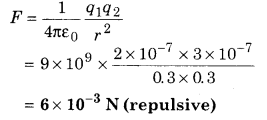
Question 2.
Two identical metallic spheres are charged with +10 μC and -20 μC. If they are kept in contact and are again placed at the same distances. What would be the ratio of the electrostatic forces in both the conditions?
Solution:
Given, q1 = 10 μC, q2 = -20C
Initially force between two spheres
F = \(\frac{1}{4 \pi \varepsilon_{0}} \frac{(10)(20)}{r^{2}} \times 10^{-12}\) ……………… (i)
Two opposite charge indicate the force of attraction
When both spheres are touched, then there is redistribution of charge, so each sphere will contain charge \(\left(\frac{q_{1}+q_{2}}{2}\right)\)
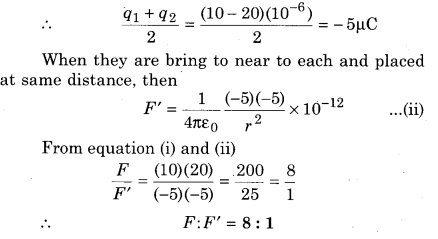
Question 3.
The vertices A and B of an equilateral triangle of side a have same charge q. Calculate the electric field at point C of the triangle.
Solution:
Electric field intensity at point C due to charge present at A
E1 = \(\frac{1}{4 \pi \varepsilon_{0}} \frac{q}{a^{2}}\) (along AC)
Electric field intensity at point C due to charge present at B
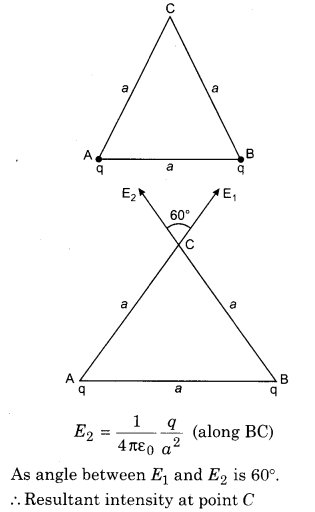
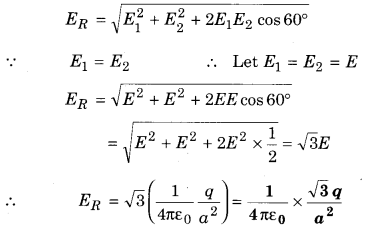
Question 4.
Two identically charged spheres are hung from equal strings. The strings make an angle of 30° with each other. When it is hanged in a liquid of density of 0.8 gcm-3, then the angle remains the same. If the density of the material of the sphere is 1.6 gcm-3, then calculate the dielectric constant.
Solution:
For the equilibrium of sphere, applying Lami’s theorem
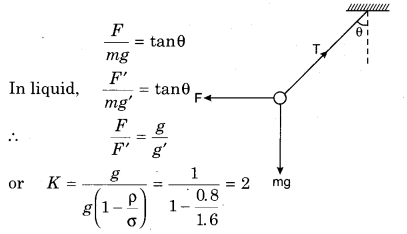
Question 5.
Two identical conducting spheres B and C are equally charged and there is a force of repulsion F between them when they are placed at some distance. The third spherical conductor is also identical to them but is uncharged. It is first kept in contact with B and then with C and is then separated. Determine the new force of repulsion between B and C.
Solution:
Initially force between two spherical conductors
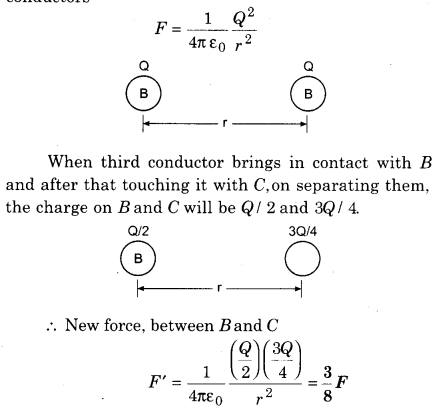
Question 6.
In given figure charges at the corners of a square of side 2 cm. Determine the direction and magnitude of electric field intensity at point O of the square. It is given that Q = 0.02 μC.
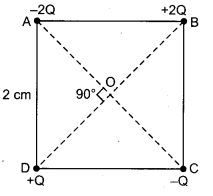
Solution:
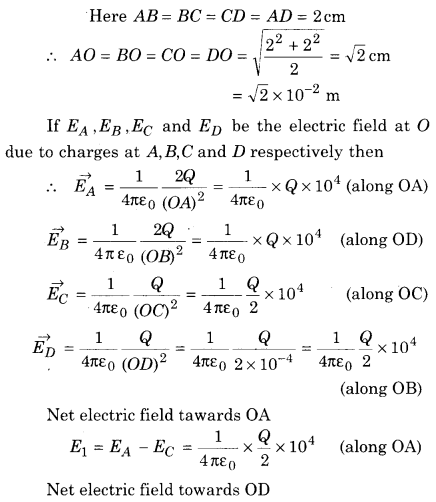
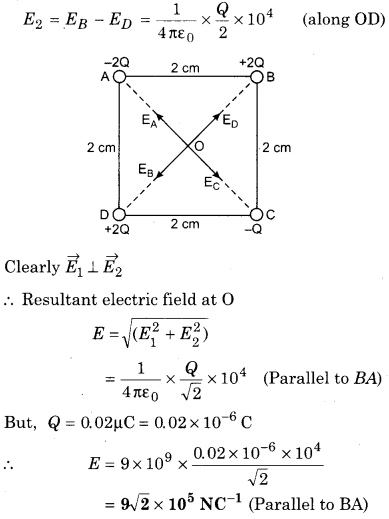
Question 7.
Electric charge Q is divided into two parts Q1 and Q2 placed at distance r. What would be condition for maximum force of repulsion between the charges?
Solution:
According to question Q = Q1 + Q2
= Q2 = Q – Q1
Coulomb force between two charges,
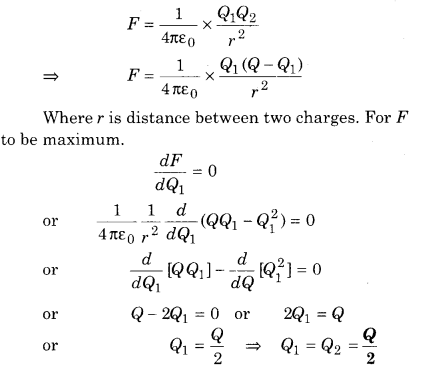
Question 8.
In given fig., an equilateral triangle ABC of side α has charges +2q, – q and -q at the vertices A, B and C respectively. Calculate the dipole moment of this system.
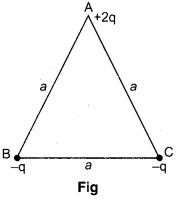
Solution:
Give arrangement is equivalent to two electric dipoles AB and AC, which are at 60° to each other.
The dipole moment of electric dipole AB
P1 = qα (along BA)
The dipole moment of electric dipole CA
p2 = qα (along CA)
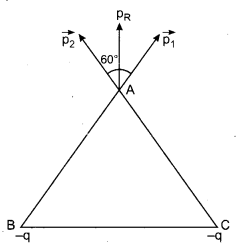
Resultant of electric dipole moment of p1 and p2
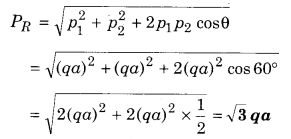
The direction of electric dipole moment PR is along half of the angle between p1 and p2 due to the equal vectors.
Question 9.
Two identical small balls, each of mass m and charge q is hung with silk thread (the length of each thread is l) as shown is given fig. The distance between them is x and angle between the threads (2 θ= 10°). Then calculate the distance x in the equilibrium state.
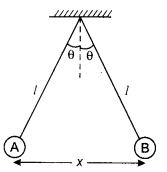
Solution:
Following forces are acting on ball A and B.
(i) Weight of ball = mg
(ii) Tension in string T
(iii) Repulsive force between both balls
F = \(\frac{1}{4 \pi \varepsilon_{0}} \times \frac{q^{2}}{x^{2}}\) ……………… (i)
Forces are in equilibrium.
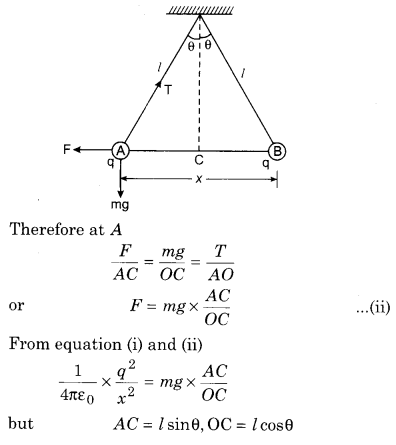
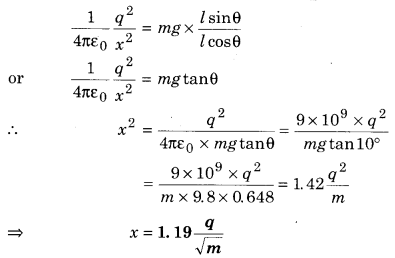
Question 10.
Two charge qA = 2.5 × 10-7C and qB = -2.5 × 10-7C are at point A(0, 0, – 15 cm) and B (0, 0, +15 cm) respectively form a system. Determine the electric dipole moment of the system.
Solution:
Position vector of point A
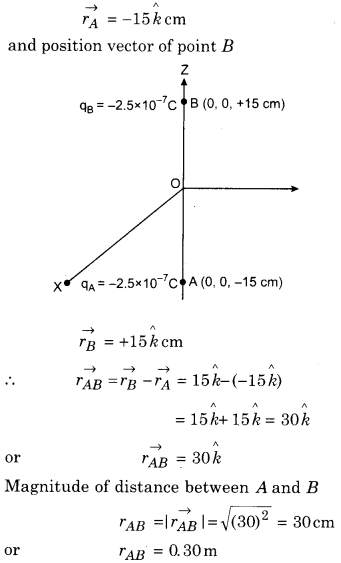
∴ Effective length of electric dipole
2l = rAB = 0.30 m
∴ Electric dipole moment
p = q × 2l = 2.5 × 10-7 × 0.30
= 0.75 × 10-7 = 7.5 × 10-8 C-m
Question 11.
An electric dipole of dipole moment 4 × 10-9 Cm is placed at 30° with a uniform electric field of magnitude of 5 × 104 NC-1. Calculate the torque acting on the dipole.
Solution:
Given, electric dipole moment
p = 4 × 10-9 Cm
Intensity of electric field E = 5 × 104 N/C
Angle between electric dipole and electric field θ = 30°, Torque x = ?
τ = pE sinθ
= 4 × 10-9 × 5 × 104 × sin30°
= 4 × 10-9 × 5 × 104 × 1/2
= 10 × 10-5 = 10-4 N-m
Question 12.
Two point charges q1 and q2 are distance 3 m. The sum of these charges is 20 μC. If a charge repels the other with a force of 0.075 N. Then calculate the value of both the charges.
Solution:
Given, F = 0.075N, r = 3 m
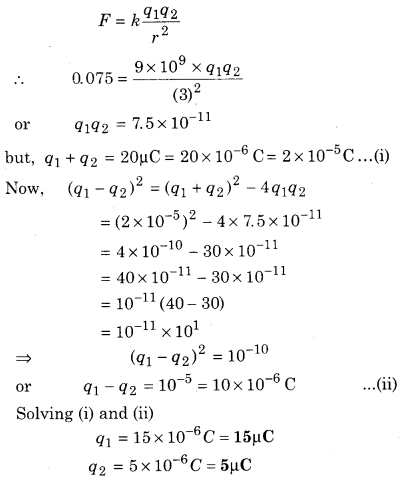
Question 13.
Two charges +10 C and -10 C are at a distance of 2 cm. Calculate the electric field at 60 cm from the centre of dipole on the axial line and the equatorial line.
Solution:
Given, q = 10C
2l = 2 cm = 2 × 10-2 m
r = 60cm = 60 × 10-2 m
(a) Electric field on axial line
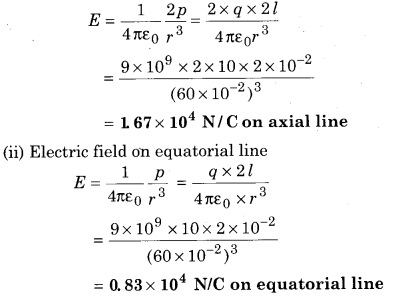
Question 14.
Two identical point charges Q are placed at some distance. A charge q is placed on the line joining in an equilibrium system. What will be the value and nature of q, so that system may be in equilibrium?
Solution:
∵ Resultant force on charge q will be zero, therefore it will be in equilibrium.

For the equilibrium of three charges, the net force on three charges should be zero.
∴ Resultant force on charge Q placed at A
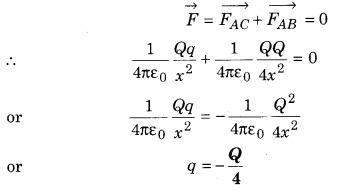
Question 15.
Calculate the ratio of acceleration of proton, deutron and an alpha particle in a uniform electric field.
Solution:
